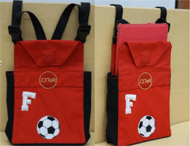Universidad Iberoamericana (IBERO), Campus: Ciudad de México (MEXICO)
Student Names: Arturo Alvarado Troncoso, Eduardo Amkie Dichi, Ariadna Cherit Hernandez, Adib Cherit Hernández, Andrea Gutierrez Hernández, Paola Yessel Raymundo Plata.
Abstract
Assistive technologies are a series of tools that are meant to tear down limitations in daily activities and dissolve restrictions in participation for people with disabilities. Therefore, this collection of gadgets could make the difference in people’s lives by helping them communicate, go to school, eat, dress themselves and have leisure activities while giving them confidence and independence. KÖBAG is a wearable device based on the universal design and intuitive paradigm, that keeps your personal belongings and school supplies safe while being trendy and practical.
Problem Statement and Background
Cerebral Palsy is an umbrella term that manifests itself in a collection of motor disorders caused by abnormal brain development or damage around the time of birth or early stages in life. Consequently, the person’s ability to move, maintain balance and posture becomes severely compromised. Spastic Cerebral Palsy (SCP) is the type of cerebral palsy where spasticity is the exclusive impairment present due to affection of the cerebral cortex. People with SCP can present mild to severe muscle stiffness (hypertonic) causing certain orthopaedic deformities of the limbs. [1]
However, schools worldwide are developing inclusive and accessible learning environments for people with a whole variety of cognitive, sensitive and physical disabilities. Universidad Iberoamericana has been developing over the years a program of this nature called: “Somos uno más“.This curriculum offers academic training, participation in artistic activities and sports. Within this program, Fernando stands out in behalf of his determination and passion for “Las Águilas del América” soccer team. Nonetheless he used to have a lot of trouble finding a practical haversack that could keep his personal belongings safe and reachable at any moment while being able to open and close the bag by himself. The major problem encountered was the lack of ergonomic design, making it complex to wear and use.
In order to address the problem previously stated, the following table was made.
User Description
|
Proposed Solution
|
|---|---|
|
|
Approach and Design Methodology
Firstly, the SCP condition was studied in order to understand and empathize with the user. Soon after previous attempts of this contraption were tested and analyzed in terms of the aspects that could be useful and improved.

As a result of that day the following brainstorming mind map was made (Figure 1):

After establishing the materials, user needs and expectations the first prototype was sketched and successively built out of paperboard, tape and plastic remains (Figure 3). This raw model was used to evaluate functionality and comfort in terms of its measurements and potential weight. During this early stage of trials, the engineering division of the team empathized with the user. In other words, each member used the model during a whole day while being on a wheelchair. At the end of the individual trials each member gave an opinion and a contribution to improve the product.

Final Approach and Design

The lid opens to the opposite side of the user, so it doesn’t hamper the user while being open. Likewise the lid and uses a magnet to keep it closed while allowing an easy opening. Finally, the design was custom made, keeping in mind the user’s favorite colour (red) and sport (football soccer).

In the following images (Figure 4 & Figure 5) the Autodesk Inventor 2018 model used to craft the haversack is shown in addition to its measurements contrasting with the real product.
Part Number
|
Description
|
Material
|
Provider
|
Price [USD]
|
|---|---|---|---|---|
MF001
|
Rigid fibber, red colour 485C on Pantene scale, 1 meter
|
Mallorca canvas
|
Parisina
|
$5.00
|
MF002
|
Expandable fibber, black colour, 1 meter
|
Spandex
|
Amazon
|
$12.88
|
MF003
|
Fibber patches for (CITeR, F, balloon logos)
|
Nylon
|
Parisina
|
$1.00 Per unit.
|
MF004
|
Black straps 2 cm width, 3 meters
|
Nylon
|
"Peletería León"
|
$1. 00 Per unit
|
MF005
|
Black paperboard: 25 x 38 cm
|
Paperboard
|
Hiperlumen
|
$0.6
|
MF006
|
Strap brooches
|
Plastic
|
"Peletería León"
|
$0.2
|
MF007
|
Magnets 2 cm width
|
Magnet
|
Parisina
|
$0.57
|
Raw costs of the prime materials: $21.25 USD per unit.
Product price per unit (Raw Materials + Product Design + Engineering Labor): $35.25 USD.
Significance
Before the project Fernando couldn’t use his iPad in his classes because taking it out of the bag was complicated. Due to the zipper, dimension and materials of the bag the IPad was stuck often, also it was difficult that he ended the day with the bag well collocated, it was regularly rolling to his legs which is a distance he cannot reach.
Changing the design and materials gave the support to use just one hand to grab the iPad, with no fabric in between or zippers, the use of a magnet to close the backpack and keep the iPad inside was enough and did not bothered him. Now he takes classes in a comfortable and independent way.
References
[1] "Somos Uno Más", http://www.ibero.mx, 2019. [Online]. Available: http://www.ibero.mx/programa-somos-uno-mas. [Accessed: 11- Mar- 2019].
[2] Parálisis cerebral infantil - Síntomas y causas - Mayo Clinic, Mayoclinic.org, 2019. [Online]. Available: https://www.mayoclinic.org/es-es/diseases-conditions/cerebral- palsy/symptoms-causes/syc-20353999. [Accessed: 01- Mar- 2019].
Acknowledgements
We are really thankful to our teachers Abel Arredondo and Maria Padilla that gave us their full support to complete this project. Moreover, to Fernando and his family for their patience and marvelous cooperation.
This is to all who love to make the impossible, possible.